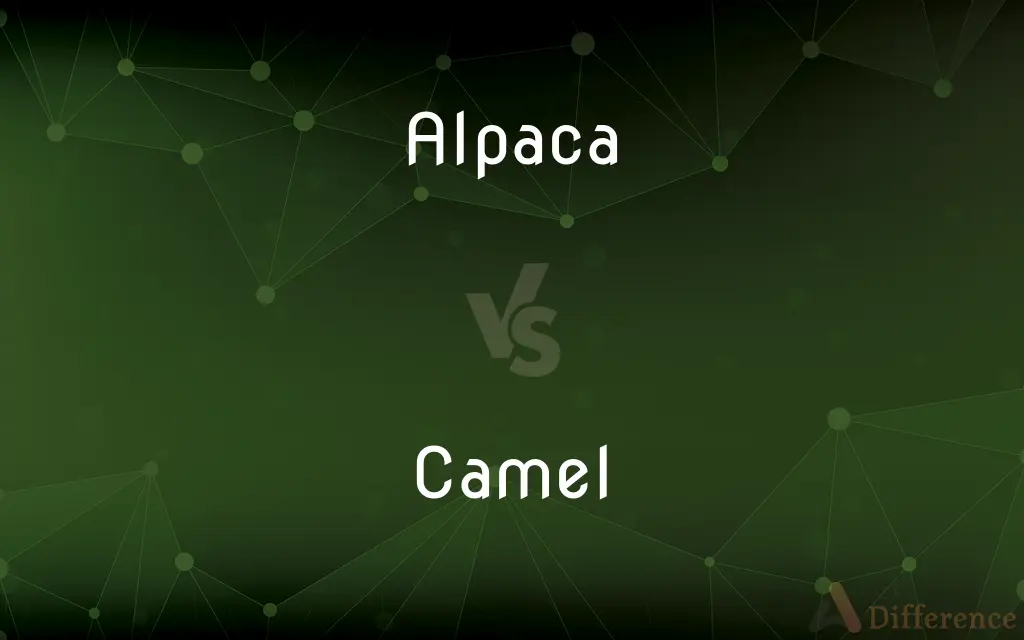Alpaca vs. Camel — What's the Difference?
Edited by Tayyaba Rehman — By Fiza Rafique — Updated on March 12, 2024
Alpacas are small, docile animals primarily raised for their soft wool, native to South America. Camels, larger and adapted for harsh desert climates, renowned for their endurance and ability to carry heavy loads, with species native to Asia and Africa.

Difference Between Alpaca and Camel
Table of Contents
ADVERTISEMENT
Key Differences
Alpacas are part of the camelid family, standing at an average of 3 feet tall at the shoulder and weighing between 100 to 200 pounds. Their wool is prized for being soft, hypoallergenic, and warmer than sheep's wool. Camels, significantly larger, can stand up to 7 feet at the shoulder and weigh up to 1,500 pounds. They are not known for their wool but for their incredible ability to travel long distances in arid environments without water, thanks to their unique physiological adaptations.
Alpacas have been domesticated for thousands of years, primarily for their fiber, which is used in making high-quality textiles. They exhibit a gentle and shy nature, making them well-suited for communal living in herds. Camels, on the other hand, have been domesticated mainly as beasts of burden and for their meat, milk, and leather. They are known for their resilience and strength, capable of carrying loads up to 900 pounds.
While alpacas are bred and raised mainly in the high Andean mountains of Peru, Bolivia, and Chile, camels inhabit vast desert regions, with the Dromedary camel in North Africa and the Middle East, and the Bactrian camel in Central Asia. This geographic distinction underlines their adaptations to very different environments: alpacas to cold mountainous areas and camels to hot, dry deserts.
Social structure differs significantly between the two. Alpacas tend to have a more hierarchical social structure within their herds, with a clear pecking order. They are also more family-oriented, often seen grazing and moving together. Camels, although they can be social, are often utilized for solitary tasks in human enterprise, such as transportation or as pack animals, reflecting their adaptation to the nomadic lifestyle of their human handlers.
In terms of reproduction, alpacas have a gestation period of about 11 months and typically give birth to a single offspring at a time, known as a cria. Camels have a similar gestation period but are known for their more rigorous mating and breeding behaviors, which can be more aggressive and competitive than those of the more docile alpaca.
ADVERTISEMENT
Comparison Chart
Size
3 feet tall at the shoulder, 100-200 pounds.
Up to 7 feet at the shoulder, can weigh up to 1,500 pounds.
Habitat
High Andean mountains of South America.
Deserts of Asia and Africa.
Primary Use
Fiber production for textiles.
Transportation, meat, milk, leather.
Nature
Gentle and shy, suitable for communal living.
Resilient and strong, adapted for harsh environments.
Adaptations
Thick wool for cold climates.
Ability to go long periods without water, thick eyelashes, and nostrils that can close.
Social Structure
Hierarchical, family-oriented herds.
Can be solitary or in groups, depending on human use.
Reproduction
11-month gestation, usually one cria.
Similar gestation, offspring called a calf, more aggressive mating behaviors.
Compare with Definitions
Alpaca
A small, wool-producing camelid native to South America.
The alpaca’s wool is used to make luxurious garments.
Camel
Domesticated primarily for transport and their ability to survive in arid conditions.
Nomads rely on camels for moving goods across the Sahara.
Alpaca
Thrives in high altitude, cold climates.
Alpacas are well-adapted to the Andean mountains’ environment.
Camel
Exhibits unique adaptations like humps for fat storage and ability to close nostrils.
Camels’ humps are essential for their survival in desert climates.
Alpaca
Prefers living in herds with a structured social order.
In herds, alpacas establish a clear hierarchy that maintains order.
Camel
Utilized for meat, milk, and leather, in addition to being a beast of burden.
Camel milk is a staple in desert communities.
Alpaca
Known for their gentle nature and soft, hypoallergenic fiber.
Alpacas are often preferred for their less itchy wool compared to sheep.
Camel
Capable of carrying up to 900 pounds, with aggressive mating behaviors.
Camels play a crucial role in trade and transportation in arid regions.
Alpaca
Produces primarily wool, with one cria per birth.
Each alpaca can contribute significantly to wool production annually.
Camel
A large, desert-dwelling mammal known for its endurance.
Camels can carry heavy loads across deserts without water for days.
Alpaca
The alpaca (Vicugna pacos) is a species of South American camelid mammal. It is similar to, and often confused with, the llama.
Camel
A camel is an even-toed ungulate in the genus Camelus that bears distinctive fatty deposits known as "humps" on its back. Camels have long been domesticated and, as livestock, they provide food (milk and meat) and textiles (fiber and felt from hair).
Alpaca
A long-haired domesticated South American mammal related to the llama, valued for its wool.
Camel
Either of two chiefly domesticated ruminant mammals of the genus Camelus, the Bactrian camel or the dromedary, having a humped back and long neck, and used in northern Africa, the Middle East, and Asia as a beast of burden and a source of wool, milk, and meat.
Alpaca
A domesticated South American ruminant mammal (Vicugna pacos or Lama pacos), related to the llama and having fine, long wool.
Camel
A device used to raise sunken objects, consisting of a hollow structure that is submerged, attached tightly to the object, and pumped free of water. Also called caisson.
Alpaca
The silky wool of this mammal.
Camel
(Sports) A spin in figure skating that is performed in an arabesque or modified arabesque position.
Alpaca
Cloth made from alpaca.
Camel
A tan or yellowish brown.
Alpaca
A fabric that imitates alpaca, made from various natural or synthetic fibers.
Camel
A beast of burden, much used in desert areas, of the genus Camelus.
Alpaca
A sheep-like animal of the Andes, Vicugna pacos, in the camel family, closely related to the llama, guanaco, and vicuña.
Camel
A light brownish color, like that of a camel (also called camel brown).
Alpaca
(uncountable) Wool from the alpaca.
Camel
Loaded vessels lashed tightly, one on each side of another vessel, and then emptied to reduce the draught of the ship in the middle.
Alpaca
An animal of Peru (Lama paco), having long, fine, wooly hair, supposed by some to be a domesticated variety of the llama.
Camel
Senseid|en|giraffe}} {{synonym of giraffe
Alpaca
Wool of the alpaca.
Camel
Of a light brown color like that of a camel.
Alpaca
A thin kind of cloth made of the wooly hair of the alpaca, often mixed with silk or with cotton.
Camel
A large ruminant used in Asia and Africa for carrying burdens and for riding. The camel is remarkable for its ability to go a long time without drinking. Its hoofs are small, and situated at the extremities of the toes, and the weight of the animal rests on the callous. The dromedary (Camelus dromedarius) has one bunch on the back, while the Bactrian camel (Camelus Bactrianus) has two. The llama, alpaca, and vicuña, of South America, belong to a related genus (Auchenia).
Alpaca
Wool of the alpaca
Camel
A water-tight structure (as a large box or boxes) used to assist a vessel in passing over a shoal or bar or in navigating shallow water. By admitting water, the camel or camels may be sunk and attached beneath or at the sides of a vessel, and when the water is pumped out the vessel is lifted.
Alpaca
A thin glossy fabric made of the wool of the alpaca, or a rayon or cotton imitation
Camel
Cud-chewing mammal used as a draft or saddle animal in desert regions
Alpaca
Domesticated llama with long silky fleece; believed to be a domesticated variety of the guanaco
Common Curiosities
Can alpacas and camels interbreed?
While alpacas and camels are both camelids, their significant differences in size, habitat, and chromosomes make interbreeding unfeasible.
What makes alpaca wool unique compared to other fibers?
Alpaca wool is prized for its softness, warmth, and hypoallergenic properties, making it superior to many other types of wool.
How do camels survive without water for long periods?
Camels store fat in their humps, which can be converted to water and energy when resources are scarce, and have the ability to fluctuate their body temperature to minimize water loss.
Why are camels important in desert cultures?
Camels are vital for transportation, food, and as a resource for materials like leather in desert cultures, facilitating nomadic and sedentary lifestyles in harsh environments.
What are the main environmental adaptations of alpacas and camels?
Alpacas have adapted to cold, high-altitude environments with their thick wool, while camels have adapted to hot, arid deserts with physiological features like water conservation and temperature regulation.
Do alpacas or camels have a longer lifespan?
Both alpacas and camels have long lifespans for livestock, with alpacas living up to 20 years and camels up to 40 years under proper care.
What are the economic benefits of raising alpacas?
Raising alpacas can be economically beneficial through the sale of their high-quality wool and breeding stock, especially in markets valuing luxury textiles.
How are alpacas integrated into Andean culture?
In Andean culture, alpacas are integral to the economy for their wool, used in traditional and contemporary textiles, and are also celebrated in rituals and as a part of community life.
Why might someone choose to use camels for transportation over other animals?
Camels are preferred for transportation in desert regions due to their ability to carry heavy loads over long distances without water, unmatched by other domesticated animals.
How do the social behaviors of alpacas and camels differ?
Alpacas exhibit a more structured social hierarchy within their herds, focusing on communal and family units, while camels can be more solitary or group-oriented depending on their use by humans.
Share Your Discovery

Previous Comparison
Chromosome vs. Gene
Next Comparison
Bobcat vs. WildcatAuthor Spotlight
Written by
Fiza RafiqueFiza Rafique is a skilled content writer at AskDifference.com, where she meticulously refines and enhances written pieces. Drawing from her vast editorial expertise, Fiza ensures clarity, accuracy, and precision in every article. Passionate about language, she continually seeks to elevate the quality of content for readers worldwide.
Edited by
Tayyaba RehmanTayyaba Rehman is a distinguished writer, currently serving as a primary contributor to askdifference.com. As a researcher in semantics and etymology, Tayyaba's passion for the complexity of languages and their distinctions has found a perfect home on the platform. Tayyaba delves into the intricacies of language, distinguishing between commonly confused words and phrases, thereby providing clarity for readers worldwide.
















































